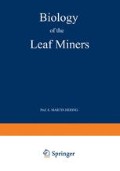Abstract
The mining larva in many cases retains throughout its life the type of mining it has chosen and in this way feeds consistently only in upper surface or in lower surface mines In a whole series of other cases, however, it changes the type of its mine on one or more occasions. Such changes in the feeding instinct frequently occur after completing a moult. They then often run parallel to changes in the structure of the mouth parts, which are now adapted to a different type of food. There are very many linear mining dipterous larvae which initially live on the under-side of the leaf in the spongy parenchyma, later continuing their channel in the palisade parenchyma on the upper-side, and then often transfer the last part of the channel back to the under-side, where they can pupate in a position less exposed to view. Such a double change of the side of the leaf infested can be frequently observed in the polyphagous Phytomyza atricornis Mg. The change from a linear-mining to a blotch mining existence can also often be found running parallel to moulting; ophiogenous blotch mines represent a transitional form between the two forms of mining. The connection between the change of skin and the change of instinct expressed in the different method of feeding can be seen particularly clearly in certain species of Bucculatrix. B. noltei Petry forms a narrow linear mine in the first larval instar in the leaves of Artemisia, resembling the mine of a Nepticula and leaving its frass in a continuous central line. It then abandons this linear mine and moults, as always in this genus, under a delicate moulting cocoon. When this process is completed, it continues feeding, but now no longer makes a linear mine like Nepticula but forms blotch mines, which are exactly similar to those of Coleophora. We find the same thing with many species of Coleophora, which first construct a mine and live inside the leaf, stacking away their grains of frass inside the mine. This first mine is usually a small blotch mine, but in other cases (Coleophora arctostaphyli Med.) a linear mine with a central line of frass similar to Nepticula. Only later does it cut a case out of the leaf, usually from the mined part, continuing its mining activity from within this case but now outside the mine, and the mines thus formed are always free of frass. (Fig. 19).
The online version of the original chapter can be found at http://dx.doi.org/10.1007/978-94-015-7196-8_26
Access this chapter
Tax calculation will be finalised at checkout
Purchases are for personal use only
Preview
Unable to display preview. Download preview PDF.
Author information
Authors and Affiliations
Rights and permissions
Copyright information
© 1951 Springer Science+Business Media Dordrecht
About this chapter
Cite this chapter
Hering, E.M. (1951). Changes in the Type of Mine. In: Biology of the Leaf Miners. Springer, Dordrecht. https://doi.org/10.1007/978-94-015-7196-8_4
Download citation
DOI: https://doi.org/10.1007/978-94-015-7196-8_4
Publisher Name: Springer, Dordrecht
Print ISBN: 978-94-015-7198-2
Online ISBN: 978-94-015-7196-8
eBook Packages: Springer Book Archive

